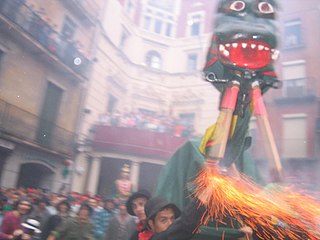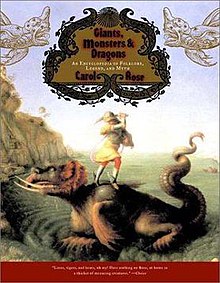
Ayida-Weddo, also known as Ayida, Ayida-Wedo, Aido Quedo, Aido Wedo, Aida Wedo, and Aido Hwedo, is a powerful loa spirit in Vodou, revered in regions across Africa and the Caribbean, namely in Benin and Haiti. Known as the "Rainbow Serpent", Ayida-Weddo is the loa of fertility, rainbows, wind, water, fire, wealth, thunder, and snakes. Alongside Damballa, Ayida-Weddo is regarded among the most ancient and significant loa. Considered in many sources as the female half of Damballa's twin spirit, the names Da Ayida Hwedo, Dan Ayida Hwedo, and Dan Aida Wedo have also been used to refer to her. Thought to have existed before the Earth, Ayida-Weddo assisted the creator goddess Mawu-Lisa in the formation of the world, and is responsible for holding together the Earth and heavens. Ayida-Weddo bestows love and well-being upon her followers, teaching fluidity and the connection between body and spirit.
In Inuit folklore, the kăk-whăn’-û-ghăt kǐg-û-lu’-nǐk or akh’lut is an orca-like composite animal that takes the form of a wolf when on land, and is sometimes depicted as a wolf-orca hybrid.
Apalāla is a water-dwelling Nāga in Buddhist mythology. It is said that Apalāla lived near the Swat River, this area is currently located in Peshawar, Khyber-Pakhtunkhwa Province, Pakistan. He is known to be a Naga King.

An ogre is a legendary monster depicted as a large, hideous, man-like being that eats ordinary human beings, especially infants and children. Ogres frequently feature in mythology, folklore, and fiction throughout the world. They appear in many classic works of literature, and are most often associated in fairy tales and legend.
Chamrosh is a bird in Persian mythology said to live on the summit of Mount Alborz.

The yale or centicore is a mythical beast found in European mythology and heraldry.

Amphiptere is a type of winged serpent found in European heraldry.
The splintercat is a legendary fearsome critter in the folklore of the United States.
Lou Carcolh, or the Carcolh, is a mythical beast from French folklore. It's described as a large, slimy, snail-like serpent with hairy tentacles and a large shell. It is said to live in a cavern beneath Hastingues, a town in the Les Landes region in southwestern France.

In American folklore, the axehandle hound is a fearsome critter of Minnesota and Wisconsin.
Freybug is a monstrous Black Dog that is stated to come from medieval English folklore, specifically from Norfolk. Like most supernatural black dogs, it was roughly the size of a calf, and wandered country roads terrifying travelers.
Abere is a demoness from Melanesian mythology. She is portrayed as a "wild" woman with young female servants. She is said to reside in marshes. She draws people to her by her beauty, entrapping them by causing reeds to grow around them. Once they are trapped, she proceeds to devour her victims.

La Guita Xica is a dragon that appears amongst the legends of Catalonia beginning in 1890. The dragon had many names, including Guita Boja, La Guita Xica, Mulaguita, La Mulassa, Mula Fera, and Mula Guita. Its name transformed over time, originally started as Mulassa, then Mulaguita, and finally Guita by the twentieth century. The name La Mulassa comes from an older term, mulassas, meaning 'monstrous mules,' which was used in Catalan mythology to refer to mule-dragon hybrids. La Guita Xica was originally considered a demon, but has become a protective spirit over the past century. It is also called a tarasca, which is a name for draconic creatures of Spanish and Latin American folklore.
The Apotamkin is a creature in Native American mythology. According to the mythology, it is a giant fanged sea monster that lives in the Passamaquoddy Bay and pulls people in to eat them, particularly careless children. It is said to have long red hair, and in some versions, it was a human woman before being changed into a serpent. One interpretation of Apotamkin myth is that it was used to instill fear into children to keep them from venturing into areas alone and without parental guidance.
Thardid Jimbo is a character in Australian Aboriginal religion and mythology. He was a cannibal giant, ultimately defeated by the resourcefulness of the family of a hunter he had killed.

The Sin-you is a mythical creature known throughout various East Asian cultures.
Dzoavits was a demon or ogre from Shoshonean mythology who stole the sun and kidnapped children. He is associated with volcanism and cannibalism. In most legends he confronts several mythological animals before being trapped in a cave, the most common one being Devils Hole.
The Aeternae were a race of legendary creatures described in the travels of Alexander the Great. As Alexander's army passed northern Indian plains, they supposedly encountered the Aeternae, who killed some of Alexander's men. The Aeternae were described as killing and wounding enemies with "bony, saw-toothed protuberances sprouting from their heads."
Dossenus is a genus of spiders in the family Trechaleidae. It was first described in 1898 by Simon. As of 2017, it contains 3 species.
The augerino is a legendary creature present in the folk tales of lumberjack and ranching communities in the western United States. Tales of the augerino described it as a subterranean creature which inhabited the drier regions of Colorado. The augerino required a dry environment to survive and would bore holes in dams and irrigation ditches to let the water drain out. Some accounts described the augerino as a type of worm, though tales differ on the exact physical description of the creature. The name appears to derive from the diminutive of the common hand tool, the auger.







